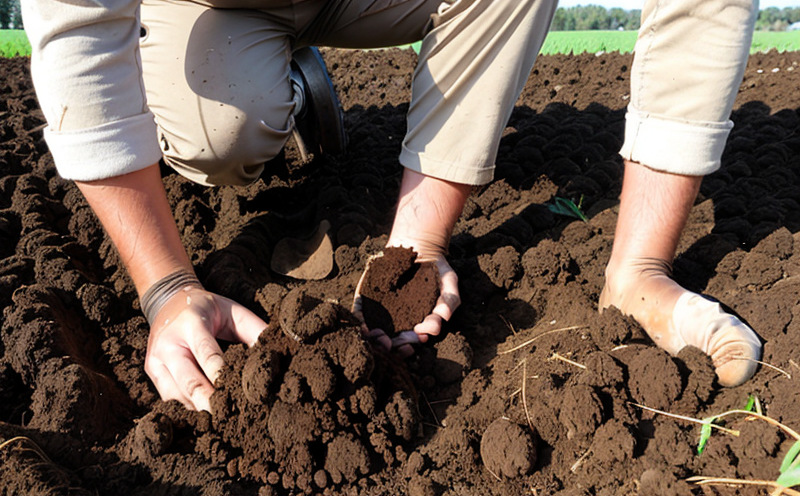Soil Gas Exchange Testing
The process of Soil Gas Exchange Testing is a critical component in understanding the health and functionality of soil. This testing method allows us to determine how gases, such as oxygen, carbon dioxide, and methane, move through soil. It plays an essential role in agriculture and forestry by assessing the soil's ability to support plant growth.
Understanding gas exchange dynamics helps in optimizing crop yields while minimizing environmental impacts. Soil gas exchange is influenced by various factors including moisture content, temperature, and soil structure. These variables can affect the diffusion of gases within the soil matrix, which directly impacts plant root respiration and nutrient uptake.
The testing procedure involves collecting soil samples from different depths to analyze the concentration levels of key gases at varying points in the profile. This helps in identifying any imbalances that might hinder optimal conditions for plants. For instance, excess carbon dioxide can lead to a condition known as "gas stress," where plants experience difficulty respiring properly due to an oversupply of CO2.
Once collected, soil samples undergo rigorous preparation processes which include sieving and homogenizing the sample before placing it into specialized chambers designed for gas exchange studies. These chambers allow controlled measurements under standardized conditions ensuring accurate results.
The equipment used in this process includes sophisticated sensors capable of detecting minute changes in gas concentrations over time. Data collected during these experiments are then analyzed using statistical methods to identify trends and correlations between different parameters affecting soil gas movement.
From a practical standpoint, accurate soil gas exchange testing provides valuable insights into managing agricultural practices sustainably. By monitoring gas exchanges, farmers can make informed decisions about irrigation schedules, fertilizer applications, and other management strategies aimed at enhancing productivity without causing harm to the environment.
In addition to its importance in agriculture, Soil Gas Exchange Testing also finds application in forestry where it aids in assessing forest floor decomposition rates and carbon sequestration capabilities. Understanding these processes helps preserve natural ecosystems by promoting sustainable practices that enhance biodiversity and support long-term ecological balance.
Why It Matters
The significance of Soil Gas Exchange Testing cannot be overstated, especially within the broader context of environmental sustainability. Accurate measurement of gas exchange rates provides crucial information about soil health and its contribution to overall ecosystem function. Healthy soils are vital not only for supporting agricultural productivity but also for mitigating climate change through carbon storage.
By tracking changes in soil gas composition over time, researchers can better predict how different management practices will influence future conditions. This knowledge is particularly important given the current challenges posed by global warming and increased atmospheric CO2 levels. Properly managed soils have the potential to act as natural sinks for excess greenhouse gases, thereby helping to combat climate change.
Moreover, understanding soil gas exchange helps in developing more resilient agricultural systems capable of adapting to changing environmental conditions. With increasing pressure on land resources due to population growth and urbanization, efficient use of available farmlands becomes increasingly important. Optimal soil management practices informed by reliable gas exchange data contribute significantly towards achieving this goal.
On a smaller scale, accurate measurements support individual farmers who want to optimize their farming operations for maximum efficiency while minimizing costs. By knowing precisely what goes on beneath the surface, they can tailor their cultivation methods accordingly leading to better yields and higher profits.
Industry Applications
In agriculture, Soil Gas Exchange Testing serves multiple purposes ranging from assessing soil health to evaluating effectiveness of various treatments like fertilizers or pesticides. Farmers rely heavily on this information when deciding upon crop rotations or choosing between different types of seeds. It aids them in creating sustainable farming practices that enhance both productivity and environmental preservation.
For forestry professionals, gas exchange testing offers insights into forest floor decomposition processes which are crucial for maintaining healthy forests. This knowledge helps maintain biodiversity by ensuring proper nutrient cycling within the ecosystem. Additionally, it supports efforts aimed at enhancing carbon sequestration capabilities of forests contributing significantly towards global climate mitigation strategies.
Environmental and Sustainability Contributions
- Carbon Sequestration: Healthy soils act as natural sinks for excess CO2, helping to reduce atmospheric concentrations.
- Biodiversity Enhancement: By promoting proper nutrient cycling within ecosystems, gas exchange testing supports increased biodiversity.
- Climate Change Mitigation: Understanding and managing soil gas exchanges can help in developing effective strategies to combat climate change.
- Agricultural Productivity: Accurate gas exchange data enables farmers to make informed decisions about irrigation schedules, fertilizer applications etc., thus enhancing overall crop yield.





